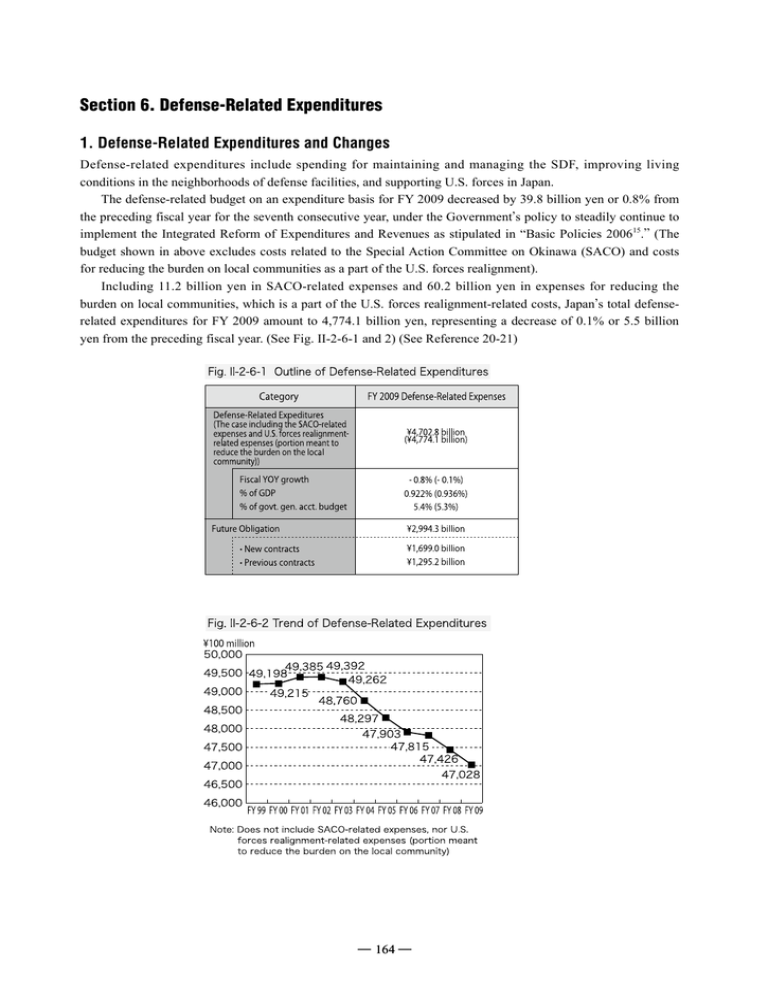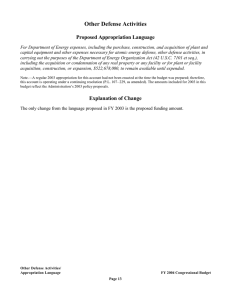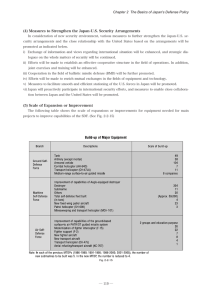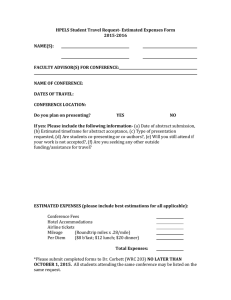Section 6. Defense-Related Expenditures 1. Defense-Related Expenditures and Changes
advertisement

Section 6. Defense-Related Expenditures 1. Defense-Related Expenditures and Changes Defense-related expenditures include spending for maintaining and managing the SDF, improving living conditions in the neighborhoods of defense facilities, and supporting U.S. forces in Japan. The defense-related budget on an expenditure basis for FY 2009 decreased by 39.8 billion yen or 0.8% from , the preceding fiscal year for the seventh consecutive year, under the Government s policy to steadily continue to implement the Integrated Reform of Expenditures and Revenues as stipulated in “Basic Policies 200615.” (The budget shown in above excludes costs related to the Special Action Committee on Okinawa (SACO) and costs for reducing the burden on local communities as a part of the U.S. forces realignment). Including 11.2 billion yen in SACO-related expenses and 60.2 billion yen in expenses for reducing the , burden on local communities, which is a part of the U.S. forces realignment-related costs, Japan s total defenserelated expenditures for FY 2009 amount to 4,774.1 billion yen, representing a decrease of 0.1% or 5.5 billion yen from the preceding fiscal year. (See Fig. II-2-6-1 and 2) (See Reference 20-21) ― 164 ― Part II The Basics of Japan’s Defense Policy and Build-up of Defense Capability 2. Breakdown of Defense-Related Expenditures Defense-related expenditures are broadly classified into “personnel and food provisions expenses,” which cover such items as pay and meals for SDF personnel, and “material expenses,” which finance the repair and maintenance of equipment, purchase of fuel, the education and training of SDF personnel, and the procurement of equipment and others. Material expenses are further classified into “obligatory outlay expenses16,” which are paid under contracts concluded in previous fiscal years, and “general material expenses,” which are paid under current-year contracts. (See Fig. II-2-6-3) The Ministry of Defense terms this classification method as “classification by expenses.” Personnel and food provisions expenses and obligatory outlay expenses, both of which are mandatory expenses, account for 80% or more of the total defense-related budget. A breakdown of general material expenses shows that ongoing or mandatory costs account for a significant portion of the total, including the repair of equipment, education and training of SDF personnel, cost-sharing for the stationing of USFJ, and expenses ― 165 ― related to measures to alleviate the burden on local communities hosting U.S. bases in Japan17. Personnel and food provisions expenses decreased by 16.7 billion yen (0.8%) from the previous fiscal year. Obligatory outlay expenses for the year decreased by 31.3 billion yen or 1.8% from the previous year while general material expenses rose by 8.2 billion yen or 0.9% from the previous year18. The breakdown of FY 2009 defense-related expenditures classified by organization, such as the GSDF, MSDF, and ASDF, and also by use, such as maintenance costs and equipment and material purchase expenses is shown in Fig. II-2-6-4. (See Reference 22) 3. Comparison with Other Countries Understanding the defense expenditures of each country using a single standard is not possible in view of differences in the socioeconomic and budgetary systems. There is not an internationally unified definition of defense expenditures, and breakdowns of defense expenditures are often unclear even in many countries where such data is publicly disclosed. (See Reference 23) Furthermore, though defense expenditures are generally converted into a dollar-termed value for the comparison, defense spending based on this method does not necessarily reflect the precise value resulted from , counting each country s price levels. , Thus, there are limits to how far a comparison can be significant simply by comparing Japan s defenserelated expenditures with those of other countries in dollar terms. For reference, Fig. II-2-6-5 displays the defense expenditures of each country shown in dollar terms using the purchasing power parity19 of each country as published by the Organization for Economic Cooperation and Development (OECD)20. ― 166 ― Part II The Basics of Japan’s Defense Policy and Build-up of Defense Capability [COLUMN] COMMENTARY The Newly-commissioned Vessels: Hyuuga and Souryuu 16DDH Hyuuga Haruna-class and Shirane-class Helicopter Destroyers (DDH) have aged severely since they have been in operation for over a quarter of a century, so they are scheduled for replacement. The successor DDH, Hyuuga, commissioned on March 18 this year, is the first helicopter destroyer with a full-length flush deck from the bow to the stern, which enhances the operational capability of rotary-wing aircraft by, for example, enabling simultaneous operation of three helicopters. Her displacement, 13,950 tons, larger than the incumbent DDH, has enhanced seakeeping ability, which allows an extended operation area and period. Hyuuga is able to serve as headquarters in joint operations, utilizing its sophisticated C4I (Command, Control, Communication, Computer, and Intelligence) function. It is expected, in addition, to serve as a control vessel not only in the defense operations of our country, such as ensuring the safety of marine traffic, but also in operations in response to new threats and diverse contingencies and in international peace cooperation activities by using its functions such as enhanced medical equipment, including an operating theatre. Hyuuga is the first destroyer which has a compartment for women. About twenty MSDF female personnel, including officers, were assigned to a destroyer for the first time, and they are expected to build their careers together with Hyuuga. Increasing the number of destroyers with compartments for women in the future will expand the world in which MSDF female personnel can play an active role. 16SS Souryuu Ever since the first submarine manufactured in Japan after the war was commissioned in 1960, MSDF has continued to make significant efforts to improve the MSDF silent force. Today 16 submarines built by Japanese shipyards are in service. The ratio of Japanese-made weapons and equipment on submarines is higher than those on other vessels, because the latest foreign technologies are not released due to the strategic nature of submarines and because Japan has world-level technologies to build advanced conventional submarines. Souryuu was put into service on March 30 this year to take over an aging submarine. She is equipped with AIP (Air Independent Propulsion), so she has the capability to remain submerged for a long time. She has an X-shaped rudder, an improved sonar system, a new type of periscope and acoustic tiles. This new equipment makes Souryuu a remarkably capable submarine in all aspects: maneuver, search, attack, stealth features and so on. The “Souryuu” was built by integrating advanced Japanese technologies and she will perform her duty in all situations from surveillance in peace time to operations in times of emergency. ― 167 ― Notes: 1) See <http://www.clearing.mod.go.jp/hakusho_data/1977/w1977_9110.html> 2) See <http://www.mod.go.jp/j/library/archives/keikaku/dp96j.htm> 3) “On Introduction of Ballistic Missile Defense System and Other Measures” (approved by Cabinet) (See Reference 28), Report by the Council on Security and Defense Capabilities <http://kantei.go.jp/jp/ kakugikettei/2003/1219seibi.html>, etc. 4) Defined in the Cabinet decision referenced in Note 3) as “Increased proliferation of weapons of mass destruction and ballistic missiles, new threats including activities by international terrorist organizations and others, and diverse situations in which peace and security are affected.” 5) (1) Not designed to directly counter military threats (2) The portion of the concept stating that Japan will maintain defense capabilities based on strategic environments and geographical characteristics in order to prevent invasion is deemed to remain effective and thus will be sustained under the new security environment. 6) Regarding the contents of talks Japan held with the United States based on ideas shown in the National Defense Program Guidelines, see Part III, Chapter 2, Section 2. 7) The Mid-Term Defense Program (FY 2005-FY 2009) stipulates that the Government of Japan will improve the research and education function of the National Institute for Defense, a think tank-like institute of the Japanese Defense Ministry, regarding security policy. 8) Major equipment of the MSDF (Aegis-equipped destroyers: four vessels) and major units of the ASDF (Air-warning control units: seven warning groups and four warning squadrons; surface-to-air guided missile units: three groups). For development of the BMD system, see Part III, Chapter 1, Section 2. 9) Total costs of defense equipment that becomes necessary throughout the full lifecycle of brainstorming sessions, the development process, mass production, operations (including maintenance and repair costs) and equipment scrapping. 10) Based on this statement, it was decided on December 24, 2005 by the Security Council and the Cabinet that the joint Japan-U.S. technical research on a sea-based midcourse system of the BMD would be succeeded by joint Japan-U.S. development in FY 2006. In a statement issued by the Chief Cabinet Secretary on the same day, it was stated that “weapons required by the United States for the purpose of joint Japan-U. S. development shall be provided under strict control and also upon coordination with the United States regarding a framework for provision of weapons.” Following this statement, the Exchange of Notes concerning the Transfer of Arms and Military Technologies was concluded by the Japanese and U.S. Governments in June of 2006. The exchange provides a framework for enabling the transfer of weapons and weapons technologies designed for the joint Japan-U.S. BMD development, as well as weapon technologies that were subject to transfer under the previous Exchange of Notes concerning the Transfer of Military Technologies. (See Part III, Chapter 1, Section 2-1 and Part III, Chapter 2, Section 3-5) 11) In June 2006, Japan decided to provide patrol vessels, which fall under the category of weapons and others under the Three Principles on Arms Export, to Indonesia as grant aid meant to support the country in its efforts to control and prevent terrorism and piracy. A statement issued at that time by the Chief Cabinet Secretary stated that the transfer of the patrol vessels was exempted from the Three Principles on Arms Export on the condition that an international agreement is concluded with the recipient country to ensure that the vessels are not used for purposes other than controlling and preventing terrorism and piracy and , that the country does not transfer the vessels to a third party without Japan s prior consent. 12) See <http://www.kantei.go.jp/jp/singi/ampobouei2/index.html> 13) See <http://www.mod.go.jp/j/info/arikata/index.html> 14) Amount of cost reduction = Initial amount (theoretical figure prior to the introduction of efficiency- ― 168 ― Part II The Basics of Japan’s Defense Policy and Build-up of Defense Capability improvement methods) − Actual expenditure 15) As a part of their efforts to restore sound fiscal standing, the Government and ruling coalition parties , conducted discussions and studies on the proposed unified reform of the nation s spending and revenue structures. As a result, specific measures to reform defense-related expenditures were laid out in the Basic Policies 2006 for Economic and Fiscal Management and Structural Reform (Cabinet endorsement on July 7, 2006). 16) Procurement of main front-line defense equipment, such as vessels and aircraft, and the construction of accommodation for SDF personnel, can take several years. In these cases, the fiscal year in which the contract is concluded is different to the fiscal year in which the payment to the contractor is made. Therefore, first of all, the maximum future (basically within five years) payment amount is appropriated in the budget as act of bearing liabilities with national treasury funds (budget authority only to incur obligations is granted, i.e., the MOD is able to conclude a contract but not to make payment). Then, based on such budgeting, in principle, in the fiscal year that construction is completed or that equipment is procured, expenses necessary for payment are allocated as budget expenditure (budget authority to incur obligations and make payment is granted, i.e., the MOD is able to conclude contracts and allocate budget expenditure). Budget expenditure for payments incurred under contracts concluded in previous fiscal years is called “obligatory outlay expenses,” while expenditure for which the payment period has yet to come is termed “future obligation.” 17) A typical cost under this category is expenses for installation of a sound-proof system in residences located near U.S. bases. 18) The comparison with the previous year does not account for SACO-related expenses and the U.S. forces realignment-related expenses (portion meant to reduce the burden on the local community). , 19) A gauge that measures each country s ability to purchase assets or services by taking into account their respective price levels. 20) The table excludes Russia and China, for which no OECD data on purchasing power parity exist. For changes in defense expenditures of each country in its local currency, see Part I, Chapter 2 and Reference 23. ― 169 ―


